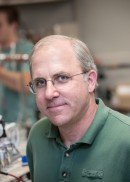Breadcrumb
O’Shaughnessy lending skills to a variety of projects evaluating PPE safety
Published on April 27, 2020

To help fill a critical shortage of personal protective equipment (PPE) for health care workers on the frontline of the COVID-19 pandemic, hospitals and health clinics everywhere are quickly adopting innovative methods to safely prolong the use of N95 respirators. Community members are also stepping up to create face shields and other protective supplies for essential workers.
Ensuring that any equipment that’s reprocessed or produced by volunteers meets safety standards is a vital step that can’t be overlooked. Experts like Patrick O’Shaughnessy, professor of occupational and environmental health in the University of Iowa College of Public Health, are lending their skills to a variety of projects that evaluate the safety of PPE.
O’Shaughnessy is a certified industrial hygienist and scientist who researches the efficacy of respirators and other protective equipment. He directs the UI Heartland Center for Occupational Health and Safety, one of 18 such centers funded by the National Institute for Occupational Safety and Health (NIOSH.) He is consulting with colleagues from the University of Iowa Hospital & Clinics and the UI College of Engineering, as well as community partners on several projects.
UI Hospitals & Clinics developed an N95 respirator decontamination process using a unique technology known as ionized hydrogen peroxide or SteraMist®. O’Shaughnessy was able to confirm that the modified process allows UI Hospitals & Clinics to safely reprocess N95 respirators up to six times instead of four without a significant reduction in functionality. (Read more about the process and a national collaboration on refining the technique.)
O’Shaughnessy is also collaborating with the UI College of Engineering on several tests, including one with David Cwiertny in the Department of Civil and Environmental Engineering to determine whether nanofiber mats produced in the lab make suitable media for respirators.
Another collaboration involves Michael Hillman, director of the College of Engineering Machine Shop, to determine whether store-bought materials make suitable media for 3D-printed respirators produced in the shop.
O’Shaughnessy is also helping community residents who are using their talents to create PPE. Kirk Cheyney is the board president of the Iowa City Fab Lab, a nonprofit “maker space” where members can access tools like sewing machines, 3D printers, soldering irons, laser cutters/engravers, computers, and more. The Fab Lab is offering its services to respond to the pandemic, Cheyney explained in an open letter posted on the group’s Facebook page.
“We are shifting footing during this crisis to produce PPE for the brave men and women at the forefront of this pandemic. Until the full-scale production starts taking hold, it is up to places like us to do all that we can for our community and the world,” Cheyney wrote. “Due to that, we have started producing face shields using factory methods and 3D printing. We are also designing prototypes for new filters and trying new ideas that we hope can help with the efforts.”
O’Shaughnessy is testing the designs to make sure they meet safety standards.
“Creating masks or supplies that do not work but look like they should is worse than making nothing at all,” Cheyney points out. “The illusion of protection is worse than no protection.”
As of April 6, Cheyney reported that the Fab Lab will have enough supplies to print 4,000 safety-approved face shields, all thanks to volunteer hours and donations.
As access to PPE supplies remain uncertain, O’Shaughnessy, along with fellow occupational and environmental health faculty members Renee Anthony, Fred Geer, and Peter Thorne, have provided advice to the Iowa Department of Public Health on design standards for surgical masks and ideas for alternative masks if current inventories run low.
Finally, O’Shaughnessy has created a four-part video series for the public to explain what types of respirators are available and how they capture particles, especially the coronavirus.
O’Shaughnessy says the long hours contributing to the fight against COVID-19 are worth the extra effort.
“It’s been a lot of work alone in the lab, but also very rewarding to be able to provide information that can be used to ultimately aid our health care workers who depend so much on PPE to maintain their good health during this pandemic,” he says.